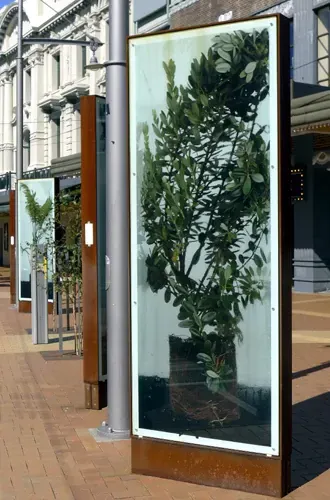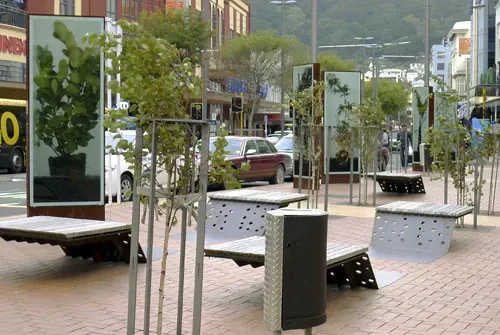Artistic Hothouse
Written by

Mark Amery writes about a public artwork in Wellington that sheds a new light on our relationship with nature.
* * *
Art frames nature as a window frames a tree. We meditate on it, decorate our homes, offices and streets with it, and generally pot it up and clip it in ways that help us kid ourselves we’ve got it all under control. Artists have assisted by bestilling nature right back to the cave paintings.
Yet as we now consider a dismal future for our planet, cultural attitudes towards plants are changing. What, where and why we plant increasingly factors in our consideration of the planet and our own self-sufficiency and health. Its only right that art might start to reflect this.
This is one reason the images of native plants by Jenny Gillam and Dieneke Jansen currently being exhibited in the lightboxes in Courtenay Place are so vital. Another is that this work does some rather distinctive things with photography and site-specific art in public space. Almost but not quite giving us the illusion that plants have been hothoused under lights in these boxes, the art subtly but powerfully registers the shift that’s underway in our thinking about plants, and equally about public art.
Featuring giant photographs of eight natives you might expect to see planted in Wellington today, there’s a uneasiness in the way these plants have been positioned like ready-mades amongst a set of actual plantings in a small city park (one quibble is they could talk in selection and positioning to them even more).
The title of the exhibition is Ever Green. The space between those two words is important. Our native plants are unusual for mostly being evergreens. In cities we often pot and contain plants to within an inch of their lives, and the results are seen in their ill health. As winter follows autumn over the three month duration of this exhibition the exotics around them will lose their leaves, while they under illumination at night like the giant advertisements around them will stay artificially verdant and lustrous.
Here the plants show the signs of having been recently unpotted, their roots and earth in that familiar cylindrical shape. Indeed, sitting on top of a layer of soil unplanted we seem to be being asking us where they should best be placed.
While Gillam’s last exhibition in Wellington featured real stick insects in the double alien environment of a vivarium within an art gallery, these new works have a charge for being in a site we are now accustomed to seeing native plants in, yet their treatment causes a double take.
Mimicing what these plants might actually look like in these lightboxes - the plants themselves have been photographed in glass boxes, and from both sides so that they can be reproduced on both sides of the lightboxes - the physical structures have a solidity which might make you pause to consider whether these plants are actually real, before noting the large uniform size of them.
Except plants aren’t comfortable in boxes. They rely on air and water and generate heat. Here the glass is steaming up and the plants starting to sweat, pressing up against the glass as if trying to escape. An allusion to climate change? This isn’t the kind of decorative trompe l’oeil (or visual allusion) of plants on the walls of houses we’ve seen historically. It’s far more unsettling.
This is a distinctive site-specific treatment of photography as a way of stilling and recording nature. The works are as sculptural as they are photographic, and charged in relation to photography’s ubiquity in giant advertisements in the city.
This exhibition marks the fourth year of the Courtenay Place lightboxes, programmed by the Public Art Panel of the Wellington City Council, of which I am a member. With projects this increasingly strong lets hope more lightboxes can start sprouting up advertising seems to increasingly do - like weeds out of cracks in the pavement - enriching our urban environment.
- Ever Green, Jenny Gillam and Dieneke Jansen, Courtenay Place Lightboxes, until 6 August

